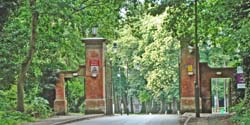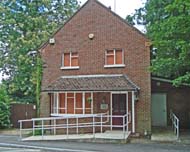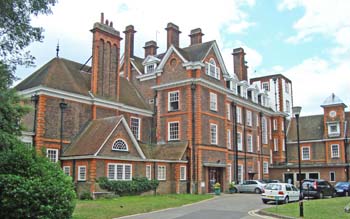Brooklands Auxiliary
Military Hospital
Military Hospital
Heath Road, Weybridge, Surrey KT13 8TU
Medical dates:
Medical character:
Convalescent (military)
In August 1915 the North Surrey
and Kingston Red Cross Branch received a request for a further 150 beds
in the area. Mr Hugh Locke-King immediately offered his own
house, Brooklands, for use as an auxiliary hospital with 75 beds.
An appeal was launched locally for subscriptions to finance the project. The estimated costs were £10 per bed and £5 for bedding, with any remaining funds to be used to cover the cost of the equipment for the wards and kitchen, and to buy benefits for the patients. Within five days, some £270 had been collected.
Brooklands Auxiliary Military Hospital was officially opened in October 1915 by Princess Christian. Affiliated to the First London General Hospital, it was designated a Class A hospital for enlisted servicemen and initially had 87 beds. Mr. A. Barclay-Walker of Firfields, Weybridge, had presented the Hospital with a fully equipped operating theatre (in December 1915 he donated a complete X-ray installation). Because of this the Hospital was able to provide more extensive surgical treatment than at most other auxiliary hospitals and several major operations were carried out during the course of the war.
Plentiful entertainment was provided for the staff and patients, and the Queen sent gifts of tobacco, games and books, particularly for the men of the Royal Newfoundland Regiment wounded during the Battle of the Somme in July 1916 (the Regiment was virtually wiped out, with 90% casualties).
In the summer of 1916 an open-air ward with 12 beds was erected, especially valuable for the treatment of very septic wounds. As the Hospital accepted more serious cases, the length of stay for each patient was about 61 days.
The Hospital had two Medical Officers and the nursing staff consisted of a Matron, 4 Sisters and 3 masseuses, assisted by the local Voluntary Aid Detachment (V.A.D) under the command of Ethel Locke-King, D.B.E. The V.A.D. comprised a Quartermaster, an Assistant Quartermaster and 14 living-in members who undertook nursing and household duties.
By 1917 the Hospital had 140 beds, with an extra 20 open-air beds available in the summer.
In the summer of 1918 it was decided to provide accommodation for 40 patients from the Special Neurological Military Hospital in Tooting. The erection of a large hut began but, just as it was more than half completed, the war ended in November 1918.
The auxiliary hospitals in the area began to close early in 1919, but Brooklands remained open until November of that year.
The hut was finally finished and opened in January 1919. It contained a small ward with 30 beds and was kept open until the remaining patients were well enough to be discharged.
The Hospital finally closed in April 1920, the last in the area to do so.
An appeal was launched locally for subscriptions to finance the project. The estimated costs were £10 per bed and £5 for bedding, with any remaining funds to be used to cover the cost of the equipment for the wards and kitchen, and to buy benefits for the patients. Within five days, some £270 had been collected.
Brooklands Auxiliary Military Hospital was officially opened in October 1915 by Princess Christian. Affiliated to the First London General Hospital, it was designated a Class A hospital for enlisted servicemen and initially had 87 beds. Mr. A. Barclay-Walker of Firfields, Weybridge, had presented the Hospital with a fully equipped operating theatre (in December 1915 he donated a complete X-ray installation). Because of this the Hospital was able to provide more extensive surgical treatment than at most other auxiliary hospitals and several major operations were carried out during the course of the war.
Plentiful entertainment was provided for the staff and patients, and the Queen sent gifts of tobacco, games and books, particularly for the men of the Royal Newfoundland Regiment wounded during the Battle of the Somme in July 1916 (the Regiment was virtually wiped out, with 90% casualties).
In the summer of 1916 an open-air ward with 12 beds was erected, especially valuable for the treatment of very septic wounds. As the Hospital accepted more serious cases, the length of stay for each patient was about 61 days.
The Hospital had two Medical Officers and the nursing staff consisted of a Matron, 4 Sisters and 3 masseuses, assisted by the local Voluntary Aid Detachment (V.A.D) under the command of Ethel Locke-King, D.B.E. The V.A.D. comprised a Quartermaster, an Assistant Quartermaster and 14 living-in members who undertook nursing and household duties.
By 1917 the Hospital had 140 beds, with an extra 20 open-air beds available in the summer.
In the summer of 1918 it was decided to provide accommodation for 40 patients from the Special Neurological Military Hospital in Tooting. The erection of a large hut began but, just as it was more than half completed, the war ended in November 1918.
The auxiliary hospitals in the area began to close early in 1919, but Brooklands remained open until November of that year.
The hut was finally finished and opened in January 1919. It contained a small ward with 30 beds and was kept open until the remaining patients were well enough to be discharged.
The Hospital finally closed in April 1920, the last in the area to do so.
Present status (July 2011)
The house is now Brooklands College, while the estate, once the location of the first purpose-built motor-racing circuit, built by Hugh Locke-King, houses the Brooklands Museum, dedicated to the history of British motorsport and aviation.


The entrance drive to Brooklands College (left) and, just inside the gates, the refurbished Margaret's Lodge (right), named in 2010 after Margaret Hicks, the Chairman of the College.

Brooklands College.
(Author unstated) 1916 British Red Cross Society, 4th Annual Report.
(Author unstated) 1917 Red Cross Work in Surrey during 1917. British Red Cross Society Society, 5th Annual Report.
(Author unstated) 1917 List of the various hospitals treating military cases in the United Kingdom. London, H.M.S.O.
(Author unstated) 1920 Red Cross work in Surrey 1918-1919. British Red Cross Society Surrey Branch.
(Author unstated) (Undated, maybe 1954) Surrey Branch Red Cross Society. Historical Summary. April 1907-31st December 1953. Aldershot, John Drew.
Smith J 1996 Monograph No. 58. Auxiliary and military hospitals in Weybridge and Walton during the First World War. Walton and Weybridge Local History Society.
Return to home page